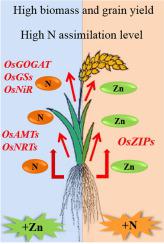Journal of Advanced Research ( IF 11.4 ) Pub Date : 2021-04-20 , DOI: 10.1016/j.jare.2021.04.005 Chenchen Ji 1 , Junli Li 1 , Cuncang Jiang 1 , Lin Zhang 1 , Lei Shi 1, 2 , Fangsen Xu 1, 2 , Hongmei Cai 1

|
Introduction
Multiple studies have shown strong relationships between different nutrients in plants, and the important role of N in Zn acquisition and translocation has been recognized.
Objectives
The aim of this study was to estimate the effect of Zn on N uptake, translocation, and distribution in rice as well as the corresponding molecular mechanisms. We also aimed to evaluate the impact of N on the Zn content in rice grains which is closely related to the Zn nutrition in humans with rice-based diets.
Methods
We conducted both field trials and hydroponic cultures of two rice cultivars to analyze the growth and yield, the uptake, translocation, and distribution of N and Zn, as well as the expression of N transport and assimilation genes, and the Zn transporter genes under different combined applications of N and Zn.
Results
Zn supply promoted the root-to-shoot translocation (12–70% increasing) and distribution of N into the leaves (19–49% increasing) and brown rice (6–9% increasing) and increased the rice biomass (by 14–35%) and yield (by 13–63%). Zn supply induced the expression of OsNRTs and OsAMTs in both roots and shoots, but repressed the expression of OsNiR2, OsGS1;2, and OsFd-GOGAT in roots, whereas it activated the expression of OsNiR2, OsGS1;1, OsGS2, and OsFd-GOGAT in the shoots. Moreover, the enzyme activities of nitrite reductase, nitrate reductase, and glutamine synthetase increased and the free NO3– concentration decreased, but the soluble protein concentration increased significantly in the shoots after Zn supply. Synergistically, N significantly facilitated the root-to-shoot translocation (1.68–11.66 fold) and distribution of Zn into the leaves (1.68–6.37 fold) and brown rice (7–12% increasing) and upregulated the expression levels of Zn transporter genes in both the roots and shoots.
Conclusions
We propose a working model of the cross-talk between Zn and N in rice plants, which will aid in the appropriate combined application of Zn and N fertilizers in the field to improve both N utilization in plants and Zn nutrition in humans with rice-based diets.
中文翻译:

锌氮协同作用对水稻根茎易位和优先分布的影响
介绍
多项研究表明植物中不同养分之间存在密切的关系,N 在 Zn 获取和转运中的重要作用已得到认可。
目标
本研究的目的是估计锌对水稻氮吸收、转运和分布的影响以及相应的分子机制。我们还旨在评估 N 对大米中锌含量的影响,这与以大米为主的饮食中人类的锌营养密切相关。
方法
我们对两个水稻品种进行了田间试验和水培,分析了不同水稻品种的生长和产量、氮和锌的吸收、转运和分布,以及氮转运和同化基因、锌转运蛋白基因的表达情况。氮和锌的联合应用。
结果
锌的供应促进了根到茎的转运(增加 12-70%)和 N 向叶片(增加 19-49%)和糙米(增加 6-9%)的分配,并增加了水稻生物量(增加了 14- 35%)和产量(13-63%)。锌供应诱导根和地上部OsNRTs和OsAMTs的表达,但抑制根中OsNiR2、OsGS1;2和OsFd-GOGAT的表达,而激活OsNiR 2 、OsGS1;1、OsGS2和OsFd的表达- 戈加特在芽中。此外,亚硝酸还原酶、硝酸还原酶和谷氨酰胺合成酶的酶活性增加,游离NO 3-施锌后芽中可溶性蛋白浓度降低,但可溶性蛋白浓度显着增加。协同作用,N 显着促进了根到茎的易位(1.68-11.66 倍)和锌在叶片(1.68-6.37 倍)和糙米(增加 7-12%)中的分布,并上调了锌转运蛋白基因的表达水平在根和芽中。
结论
我们提出了水稻植物中锌和氮之间相互作用的工作模型,这将有助于在田间适当组合施用锌和氮肥,以提高植物的氮利用率和人类的锌营养。饮食。











































 京公网安备 11010802027423号
京公网安备 11010802027423号